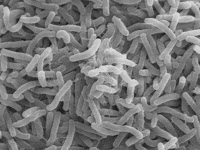Bacteria are the most abundant
group of microorganisms in nature. It is found everywhere on the planet,such as
hot spring,deep ocean,deserts and even thrive inside our intestine. The term
bacterium was given by Ehrenberg. The branch which is deals with
bacteria is known as Bacteriology. Unlike many organisms, bacteria have no
natural death.
- Smallest bacteria: Dialister
pneumonsintes
- Largest bacteria: Epulopiscium
fishelsoni
 |
| Bacteria |
General Characteristics
- Bacteria are prokaryotic organisms (Kingdom:Monera), without cell defined organelles like mitochondria,Golgi bodies,Endoplasmic reticulum.,etc.
- Microscopic, unicellular, they may occur singly or aggregations to form colonies.
- They posses rigid cell wall. Cell wall is made up of peptidoglycan (Mureins) and Lipo polysaccharides.
- Absence of well defined nucleus.i.e., DNA is not enclosed in a nuclear membrane.
- Ribosomes are scattered in the cytoplasmic matrix and are of 70S type.
- The plasma membrane is invaginated to form mesosomes.
- Most of the bacteria are heterotrophic. Some bacteria are autotrophic, posses bacteriochlorophyll, which is not in plastids. Instead it is found scattered.
- Motile bacteria posses one or more flagella.
- The common method of multiplication is binary fission.
- True sexual reproduction is lacking,but genetic recombination occurs by conjugation ,transformation and
transduction.
Shape of Bacteria
1.Cocci- Spherical or ellipsoidal
- Micrococci- ex:Micrococcus
- Diplococci ex:Diplococcus pneumoniae
- Streptococci- ex:Streptococcus
- Staphylococci- ex:Staphylococcus aurens
- Tetracocci- ex:Genus Micrococcus often divide in two planes to form square groups of 4 cells called Tetrad
- Sarcine- ex:Sarcina lutea
- Vibrio- ex: Vibrio chlorae
3. Spirillum- Spiral shaped ex:Spirillum volutans
4. Other shapes
- Mycellium - ex: Streptomyces
- Pleomorphic- ex: Corynebacterium diphtheriae
Tags:
70S
bacterial cell wall
Bacterial Flagella
Bacterial Recombination
bacteriochlorophyll
kingdom monera
Largest bacteria
recombination
Shape of Bacteria
Smallest bacteria

